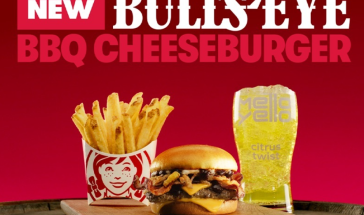Investing in Quality & Making Progress on Animal Antibiotics
We’ve just published a year-end recap of our corporate responsibility efforts at Wendy’s. Having now done this twice, it’s fair to say this is a practice we will follow on at least an annual basis. It was a busy year with encouraging progress on several fronts, and we spent a lot of time working on sustainable food issues related to the livestock in our supply chain.
By the Chinese lunar calendar, 2017 was the year of the rooster. But for us, it wasn’t just about chicken, it was also the year of the cow and the pig. We invested heavily in our food quality, working closely with our suppliers and livestock producers to reduce the use of antibiotics while protecting the well-being of the animals we rely on for food.
Since our founding, our slogan has been “Quality is our Recipe.” For a brand that serves fresh, never frozen beef, as well as chicken and pork, we long ago recognized that the quality of our food was directly related to the treatment of the animals that are raised to provide it. That’s why we staff an internal team of quality assurance experts who hail from backgrounds in food and agricultural science and partner with the best suppliers in the industry to assure the welfare of the animals in our food supply. None of that has changed, but in 2017, consumer expectations and changing industry conditions allowed us to up our game significantly.
Chicken Milestones
One area of focus was chicken and we saw an opportunity and a need to improve quality significantly. We put in place a maximum bird size requirement so that the chicken in our products didn’t grow beyond seven and a half pounds. This $30 million investment substantially improved the tenderness and juiciness of our chicken sandwiches. We were so encouraged by the success that we expanded our chicken line in October to include Chicken Tenders (seriously, try that Side of S’Awesome™ sauce. You won’t be disappointed).
Around the time our Chicken Tenders were launching nationally, we also reached another chicken milestone by completing our work to remove any antibiotics from our chicken supply that are considered medically important, meaning they’re a kind of antibiotic that you or I might be given for an illness. We made this commitment last year recognizing that there is a growing public health concern about antibiotic resistance and believing that we could help by reducing or eliminating antibiotic use in our food supply. We spent the better part of this year working with our suppliers to make the change, and as of September, all new chicks destined for Wendy’s chicken have been raised this way.
We also said last year that we’d pursue similar goals for antibiotic use in our beef and pork supply, but that would take a little more time. Those animals live quite a bit longer than chickens, so it’s just harder to keep them antibiotic-free throughout their life. We still have some work to do, but we’re encouraged by where we’re headed.
Our Progress
First, a little background on what makes our products unique, and that’s the idea of purposeful sourcing. We buy protein products that were raised for a specific purpose, not by-products that are left over from another use. For us this means paying more for premium meat including:
-
Younger cattle raised specifically for high quality beef grades such as USDA Prime, Choice, and Select as part of our “Fresh, Never Frozen” promise; not older dairy or beef producing cows.
-
Market hogs raised for sausage and bacon; not sows (or mother pigs) raised for breeding.
-
Broiler chickens that adhere to our smaller-bird size requirement as part of our commitment to quality and animal welfare; not older larger chickens or egg-laying hens.
Don’t get me wrong, there’s nothing inherently wrong with these older animals, but with a younger protein supply chain, we believe we bring a quality advantage to our customers. And because they’re younger, we also believe that these animals had less time to need, or receive, antibiotics. We don’t think that’s enough though, and that’s why we’re focusing on traceability in our fresh supply chain so we can find out as much as possible about the animals that were raised for our food. This way, we can verify what treatment they received during their life, identify how that could be improved, and report publicly on what we find and where it can be better.
To start, we looked at our beef supply. If you’ve ever watched TV or stumbled upon @Wendys on Twitter, you probably already know that we use fresh, never frozen beef, and we’re pretty proud of that. For that to be true, it means all the cattle that become our hamburgers are fed and harvested in the U.S. My colleague Sarah explained how we do that in a blog last year and she said that we spend our time not just with beef patty makers, but also with the suppliers that “cut” the beef (the facilities where the animals are slaughtered and trimmed into various cuts of beef). We also spend a good amount of time with the cattle feeders who house these animals before they are slaughtered, but we’ve typically not had a specific business relationship with them.
Decreasing The Use Of Antibiotics
This year, we started changing that and engaging in a dialogue with progressive-minded cattle feeders about the cattle industry and how we could decrease the use of antibiotics. Today we have a partnership with a group of cattle feeders who supply us with about 15% of our beef.
Together, they’ve agreed to reduce the only medically important antibiotic routinely fed to their cattle by 20% to start, and they’re going to continue reducing in the future. We don’t know anyone else of our size who has done this, and it’s a heck of a lot harder to do than you might think, but we think we’re on the right path.
As we go forward, we have a goal of eliminating routine antibiotic use in our beef and pork supply, while protecting the need for targeted, therapeutic use of an antibiotic in the limited cases where a sick animal needs to be treated individually, or in the unlikely case that animals have been exposed to an illness and treatment with an antibiotic is necessary to prevent a disease outbreak.
We have the same goal for our pork supply as we do for beef. All our pork comes from producers in the Pork Quality Assurance Plus program. This is an industry certification that requires producers to, among other things, adhere to a new federal standard called the Veterinary Feed Directive. We believe this directive has already yielded a decrease in antibiotic use throughout the industry, but that has not yet been quantified industry-wide because the standard just went into effect within the last year. We are focused on our specific suppliers and are now working to develop relationships with hog farmers, just like with cattle feeders, so we can go further back into our supply chain and affect changes. We'll partner with like-minded, progressive producers who are committed to implementing new production practices to help reduce the need to use antibiotics, and those who will share their progress regularly and transparently with us. We're confident these producers are focused on the stewardship of antibiotics for the good of people, as well as the animals in their care.
Our commitment to you is that we will keep these issues front and center. We’ll measure antibiotic use throughout our protein supply chain with a goal of decreasing it wherever we can, and we will report about it publicly at least annually.
Anything else you’d like to hear about? Let us know and we’ll tell you what we think.



